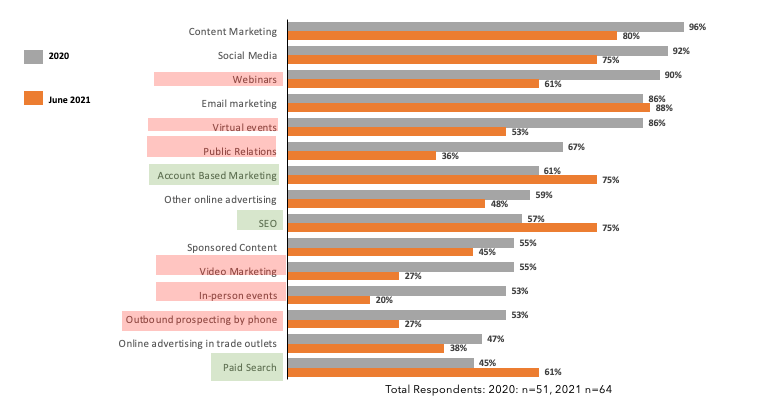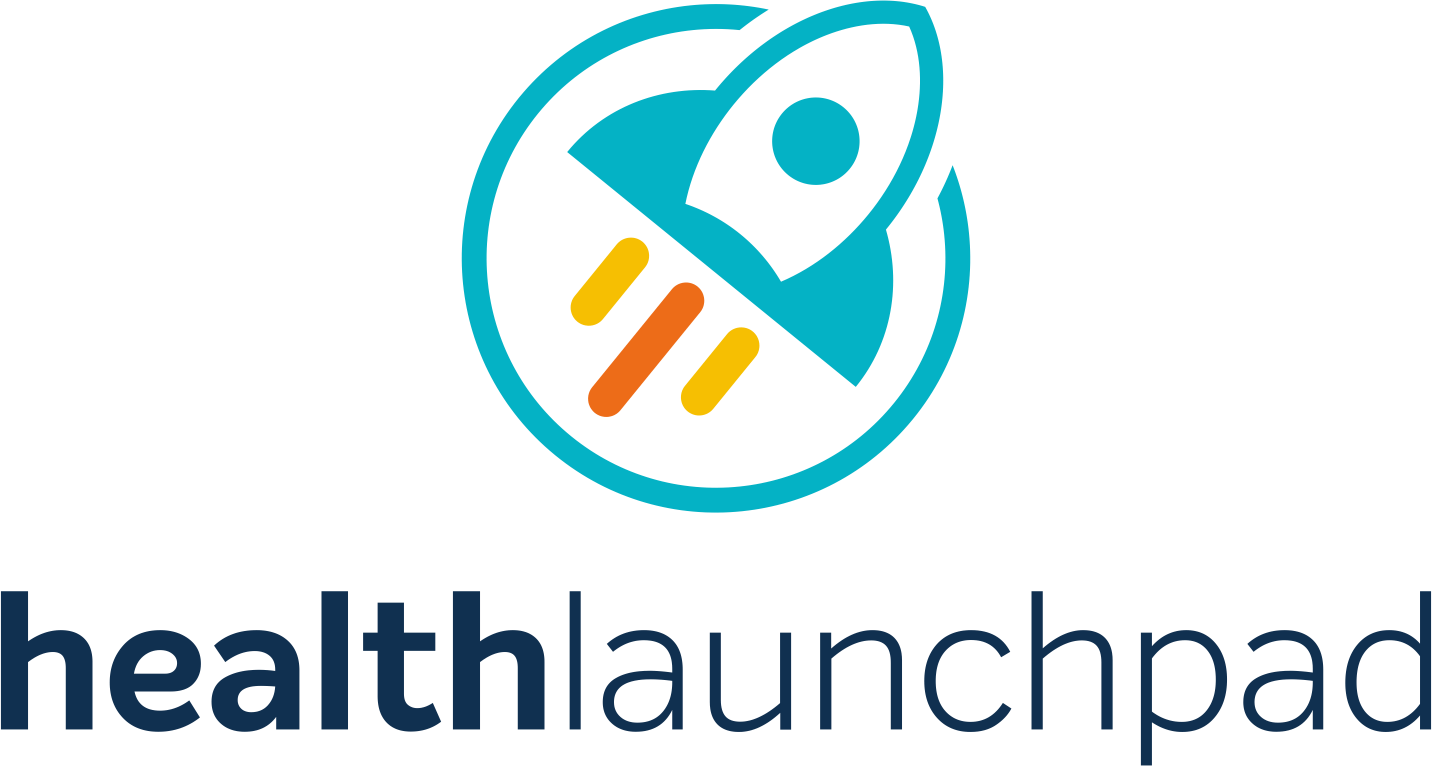Over the last few months, I have spoken with many healthtech executives about how their B2B marketing strategies have changed over the last three years.
They have told me how they have had to adapt to the turmoil created by the pandemic.
Moreover, in late 2020 and 2021, healthlaunchpad in partnership with HIMSS, conducted two waves of research on healthcare B2B marketing.
Specifically, we surveyed healthtech marketers on their marketing strategies to understand what was changing as a result of the pandemic. (You can view the webinar on the second wave here.)
Healthtech B2B Marketing Strategies – What’s Up and What’s Down?
This chart from the 2021 wave of the healthtech marketer survey shows what B2B marketing approaches they employed. In green, we have highlighted the B2B marketing tactics that marketers increased in use. In red, are the tactics that declined in use.

At a tactical level, there was a great deal of change in the marketing mix. There was a 15%+ change either up or down across the majority of tactics as marketers added or increased the use of some tactics. They reduced or eliminated others.
It is also striking that most marketers use the same core tactics, ie. content, social media marketing, email, ABM, SEO, and paid search.
So while there was a lot of tactical shuffling, when it comes to B2B marketing, there isn’t much differentiation in the strategies healthtech companies employ.
So what strategies have healthtech marketers employed to differentiate?
It’s the Customer Stupid
In March, we conducted a webinar with 5 leaders in healthcare B2B marketing.
The first topic was how they had adapted. Specifically what was the most important lesson from the pandemic. In short…
Focus on the customer
In this two-minute video, marketers discuss how they increased their focus on the customer
The pandemic forced these marketers to step back and think hard about how to adapt their B2B marketing strategy.
The single most important thing was to be more customer-centric.
They sought to create an advantage by being better at understanding the customer. They also optimized their marketing to be more customer-centric.
Now, you may be thinking, “Well that’s obvious. Aren’t we all customer-centric?”. The reality is that some are more customer-centric than others.
How Do You Make Your B2B Marketing More Customer-centric?
We have observed some common traits of effective customer-centric B2B marketing.
This is based on the work we do for clients. In addition, it is informed by the research we conducted with HIMSS.
Lastly, the interviews we do for the Healthtech Marketing Podcast provided more insights. The pandemic forced everyone to raise their game across these traits.
1. Being Hyper-empathetic
As marketers, there is always a tension between the needs of your company and the needs of your customers.
It’s natural to be more focused on what “we” need versus what “they” need. The pandemic forced marketers to work harder at putting themselves in the shoes of their customers. Empathy became much more important.
In this video, Melanie Turner, AVP, HSIS, UAB Medicine Enterprise, goes into what it feels like to be sold and marketed to.
The best marketers understand her and know how to build trust with buyers like Melanie. Companies that fail to understand her and treat her empathetically go nowhere.
Melanie Turner, AVP, HSIS, UAB Medicine Enterprise on building trust
Some examples of hyper-empathy in action include being much more personal and personalized in marketing tactics; stopping before sending out an email campaign and asking how it will be received; being better at predicting what they need; using new types of data to be better at understanding needs.
2. Meet the Customers Where They Are
No one could rely on in-person events or on-site meetings in 2020 and even 2021. Marketers have had to become smarter at understanding where customers were spending their time. And what they would be most willing to engage with.
Webinars served a need in the early phase of the pandemic. They became less effective in 2021 as customers became weary of them.
It is important to recognize that customers spend most of their research and investigative time in “dark channels”, i.e. online on information websites and social media where they are hard to engage.
Buyers want the ability to research on their own without interacting with you until they are ready. Intent data can be very helpful as it provides guidance on what topics buyers are most interested in.
The more customer-centric marketers use intent data and first-party research (e.g. interviews and customer feedback) to shape their content strategy and then distribute the strategy across the touchpoints where prospects seem to spend the most time (e.g. LinkedIn, HIMSS online events).
Many marketers are shifting away from email marketing to better use of social media
Email does not seem to work as well as it used to. Why? Buyers receive hundreds of unsolicited emails each month and tune them out.
Buyers use social media like LinkedIn to understand what’s hot, what’s new, and what they need to learn more about. Their peers shape their opinions.
Being able to engage buyers in an authentic way is a skill that marketers have to master.
In this video, Jim Rose, the CMO of Intersystems explains why they are moving away from email and how they are finding and engaging influencers through social media.
Jim Rose, Global CMO, Intersytems on the use of social media
When all this has been figured out, then the task is to plan a sequence of tactics that map to the journey your customers take as they look for answers.
One of the key skills of effective customer-centric marketing is journey mapping, turning insights about customer behavior and what information they want and when into a carefully planned journey map.
3. Multi-touch Attribution is Key
And as you get smarter about careful journey mapping, you need a measurement strategy that tracks engagement throughout the journey.
This requires multi-touch attribution that recognizes the value of unknown prospects engaging with content early in their journey, the importance of social media engagement as well as later stage tactics such as content downloads or responding to an SDR.
Customer-centric marketers use more sophisticated forms of measurement, for example:
- Differentiating between high and low engagers
- Measuring engagement of best-fit target accounts versus others
- Being able to track the influence of an ABM campaign across the entire customer lifecycle
In this blog post, Ben Person, the CMO of Nuvolo, goes into how they measure the impact their ABM programs have across the funnel.
4. Mastering Educational Content + SEO are Critical In B2B Marketing
When your prospect goes online they are looking for answers to questions.
As a marketer, your job is to answer those questions better than your competition and ensure that they find your content first.
As you plan your content and search engine strategy, start by understanding the questions your buyer prospects have.
This technique is brilliantly discussed by Marcus Sheridan in his seminal book, They Ask You Answer.
Developing personas can help with this but in our view, the key aspect of any persona is understanding what questions the prospect has at the different stages of the buyer journey.
Your content strategy should be to answer these questions with content that informs and educates.
You will build trust and consideration with content that addresses their questions and provides answers that are as informative and objective as possible.
The second trick is to study search behaviors and intent data. Knowing what terms are being searched currently tells you what buyers are interested in. Intent data helps you further by shining a light on the topics that your target accounts are investigating.
Creating and optimizing content for these topics will give you a competitive advantage as it will most likely get found and read by your competition faster.
What You Can Do Next
There are many ways you can make your B2B marketing more customer-centric. In future posts, I will share ideas on how to do this in detail. As a starter, here are three things you could start today:
- In-depth Customer Interviews: Conduct interviews via zoom with your customers. Use these to gain feedback from them on your firm is performing. You can position this to them as a way to understand what you can do to address their needs more effectively. During these interviews, get their feedback on your marketing, your messaging, the tactics you use, and the content you are developing. They can tell you what buyers like them will find appealing and what does not work well.
- Look at Intent Data: You can license ABM intent data directly from Bombora or Zoominfo. You can use this data to understand what topics related to what your firm does are most interesting to your target customers.
- Update Your Personas: If you use personas, do you try to capture the questions that they have at different stages of the funnel? This is an example of a simple persona where the focus is on their questions.
You can get this done quickly in a brainstorming session. Try to include salespeople and SDRs in this process as they are talking to prospects regularly and will have a good sense of what the questions are.
If you would like to learn more about any of these ideas, start a customer-centricity initiative, get help interviewing your customers, develop a feedback program, test intent data, or develop better journey maps we can help.
You can reach me at adam@healthlaunchpad.com.
***************
Relevant Links
- B2B Healthcare Social Media Marketing
- Turning Stakeholders Into Events Promoters
- The Future of Events & Experiential Marketing
- Use and Benefits of ABM
- How to Plan for Marketing Campaign Optimization
- Why You Should Consider ABX
- ABM & Social Media – The 4 Campaign Stages
Originally posted on LinkedIn.

